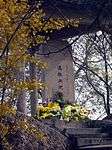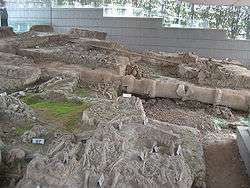Nanjing Massacre Memorial Hall
| This article is part of the series on |
| Nanking Massacre |
|---|
| Japanese war crimes |
| Historiography of the Nanking Massacre |
| Films |
| Books |
The Nanjing Massacre Memorial Hall or Memorial for Compatriots killed in the Nanjing Massacre by Japanese Forces of Aggression (simplified Chinese: 侵华日军南京大屠杀遇难同胞纪念馆; traditional Chinese: 侵華日軍南京大屠殺遇難同胞紀念館; pinyin: Qīnhuā Rìjūn Nánjīng dàtúshā yùnàn tóngbāo Jìniànguǎn) is a hall to memorialize those that were killed in the Nanjing Massacre by the Imperial Japanese Army in and around the then capital of China, Nanjing, after it fell on December 13, 1937. It is located in the southwestern corner of Nanjing known as Jiangdongmen, near a site where thousands of bodies were buried, called a "pit of ten thousand corpses" (simplified Chinese: 万人坑; traditional Chinese: 萬人坑; pinyin: wàn rén kēng).
Nanjing Massacre
On December 13, 1937, the Japanese army occupied Nanjing (also referred to as Nanking)–then the capital city of the Republic of China. It is widely accepted that during the first six to eight weeks of their occupation, the Japanese army committed numerous atrocities, including rape, arson, looting, mass executions, and torture. There is, however, denial over the scale of the massacre, especially in Japan where many ultranationalists even go so far as to claim that the massacre never occurred.
China estimates that approximately 300,000 civilians and unarmed Chinese soldiers were brutally slaughtered. This estimate was made from burial records and eyewitness accounts by the Nanjing War Crimes Tribunal and included in the verdict for Hisao Tani.
Corpses littered the streets and were seen afloat in rivers for weeks, and many structures in the city were burned down. Countless shops, stores, and residences were looted and sacked.[1]
Japanese soldiers were also reported to have conducted killing competitions and bayonet practice using live Chinese prisoners. Approximately 20,000 cases of rape occurred within the city during the first month of the occupation, according to the "Judgement of the International Military Tribunal".[2] Even children, the elderly, and nuns are reported to have suffered at the hands of the Imperial Japanese army.[3]
Memorial Hall
The Nanjing Memorial Hall was built in 1985 by the Nanjing Municipal Government in memory of the 300,000 victims who lost their lives during the Nanjing Massacre. In 1995, it was enlarged and renovated. The memorial exhibits historical records and objects, and uses architecture, sculptures, and videos to illustrate what happened during the Nanjing Massacre. Many historical items were donated by Japanese members of a Japanese–Chinese friendship group, which also donated a garden located on the museum grounds.
It occupies a total area of approximately 28,000 square meters, including about 3,000 square meters of building floor space.
The memorial consists of three major parts: outdoor exhibits, sheltered skeletal remains of victims, and an exhibition hall of historical documents.
Outdoor exhibits
The outdoor exhibit include statues, sculptures, relief carvings, tablets, and a large wall listing the names of victims, as well as an atonement tablet and memorial walkway. The memorial walkway displays footprints of survivors, some of which were impressed as recently as 2002.
- Nanjing Massacre Memorial



 Iris Chang statue
Iris Chang statue Yanziji Nanjing Massacre Memorial in 2004
Yanziji Nanjing Massacre Memorial in 2004
Skeletal remains

The skeletal remains of massacre victims, now exhibited in a coffin-shaped display hall, were excavated from Jiangdongmen in 1985; 208 more were uncovered in 1998.
Exhibition hall
The tomb-like exhibition hall, half underground, contains more than 1000 items related to the massacre, including an immense collection of pictures, objects, charts, and photographs. Paintings, sculptures, illuminated display cabinets, multimedia screens and documentary films serve to demonstrate to visitors the crimes committed by the Japanese military.
Transportation
The memorial hall is accessible within walking distance west of Yunjinlu Station of Nanjing Metro.
References
- ↑ John E. Woods, The Good Man of Nanking, the Diaries of John Rabe, 1998 P. 275-278
- ↑ Nanjing Massacre Memorial Site 200
- ↑ John E. Woods, The Good Man of Nanking, the Diaries of John Rabe, 1998 P. 275-278, 281
Kirk A. Denton, Exhibiting the Past: Historical Memory and the Politics of Museums in Postsocialist China (University of Hawaii Press, 2014), pp. 143–49.
External links
| Wikimedia Commons has media related to Nanjing Massacre Memorial Hall. |
Coordinates: 32°2′7.90″N 118°44′36.67″E / 32.0355278°N 118.7435194°E
